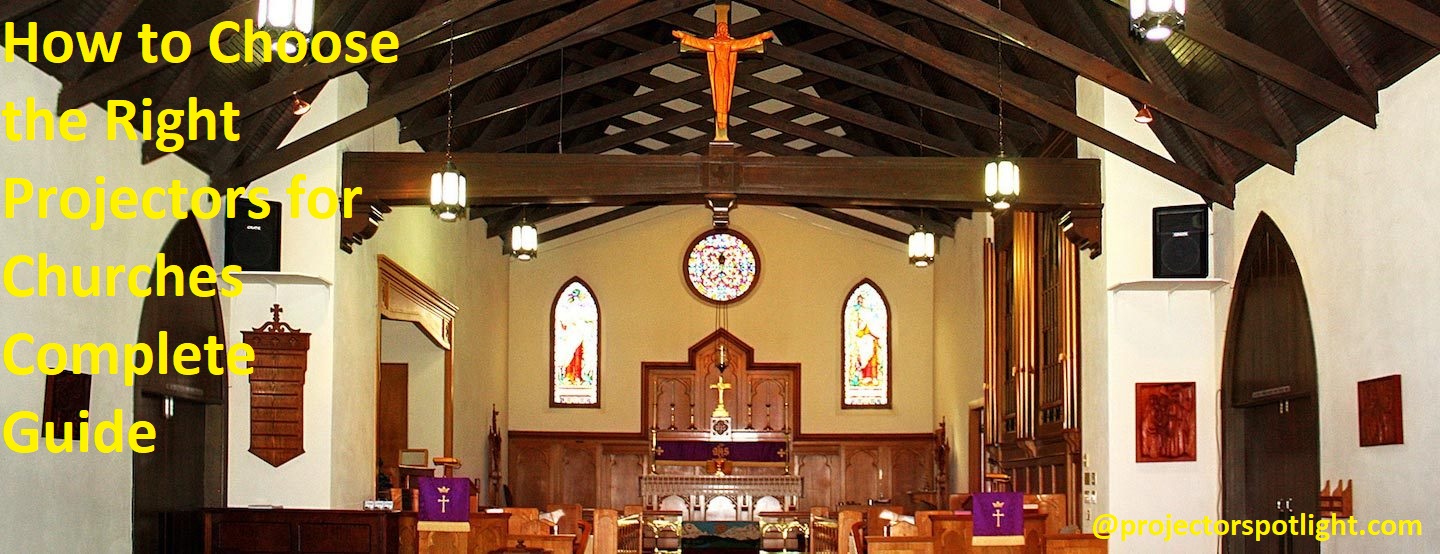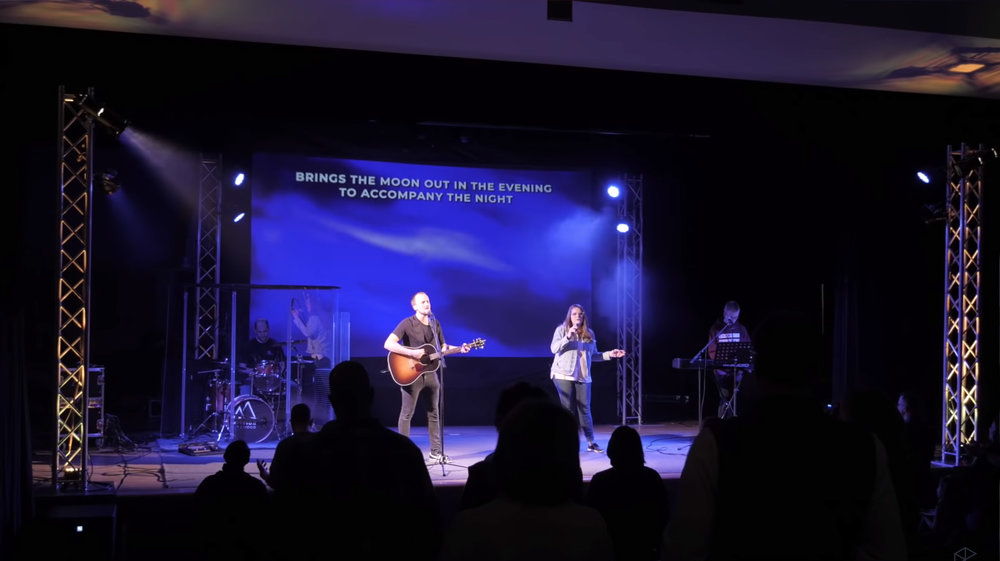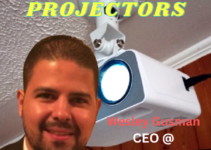Are you feeling overwhelmed by the complexities of choosing the right projectors for your church? Don’t worry!
In this article, you will get a complete guide on how to select the right projectors for churches. So, keep reading and learn more!
Projectors play an important role in the success of religious services by allowing churches to connect with their congregations in unique and powerful ways. In today’s digitally-driven world, it is essential that churches have the right projection tools and understanding of the basics to best communicate their stories from day-to-day sermons and prayer services to special event holiday productions.
The following guide addresses the common concerns associated with projectors for churches and provides advice on how to select a projector for churches based on budget, usage, environmental conditions and scalability. Understanding how brightness, resolution, color range, aspect ratio and other characteristics influence image quality can help churches make informed decisions when choosing projectors for their own space.
Considerations Before Purchasing a Projector
When selecting the best projector for a church, there are a few key considerations to bear in mind, such as whether it is necessary to project media in multiple zones; the appropriate brightness level; the space of the venue and any other requirements related to placement or installation; budget constraints and connectivity options.
Brightness: It is important to consider how much light is available in the room where you plan to use your projector. Most projectors for churches will specify their level of brightness (in lumens), and this is an essential factor when considering which one is best suited for your needs. A higher lumen rating means more light output and more intense images on a bigger screen – perfect for crowded venues.
Pixel Resolution: Projectors are also measured by their pixel resolution which indicates how many pixels (individual points of colour) are contained within one image of viewable space. This factor should be taken into consideration not less because it will affect image quality, contrast ratio, pixelation of still images, etc..
Connectivity: Many people assume that all projectors have HDMI ports but this isn’t always so. Make sure you are aware of what ports you will need in order to connect other devices (such as Dish Network boxes or laptop computers).

Church size
Choosing the right projectors for churches depends on multiple factors, including the size of the church and the audience. For larger churches that are looking to fill a large area, it is best to use projectors with higher lumens and higher resolutions. Most projectors used in churches today have 4K resolution or 1080P resolution and brightness ranging from 3,500 to 10,000 lumens.
For smaller petite churches with a limited-sized congregation, projectors with lower lumen requirements can be used additional savings on cost or better coverage/brightness than traditional TV’s or screens (although be aware of throw distance). The optimal size for these situations would usually be in the range of 2,000 – 4,000 lumens. XGA (1024 x 768) would be sufficient for these types of applications as well.
Most presenters at church events tend to provide image slides that don’t require higher resolutions so it may not be necessary to purchase projectors with higher resolutions unless you are frequently utilizing video content from DVD’s or streaming services like Netflix or Hulu.
Seating capacity
When selecting a projector for church use, one of the most important considerations is seating capacity. The amount of seating determines the projection distance from the screen, which determines the brightness level of the projected image. In most cases, a bright picture is required; therefore, projectors with high lumens outputs are recommended.
If a longer projection distance is required than what is available with a given model, adding an audio-visual amplifier can help increase brightness levels. Be sure to calculate seating capacity correctly, as this will determine image size and how many lumens are needed to produce a bright image.
Room lighting
Room lighting plays an important role when choosing projectors for churches. Since churches are usually well-lit during services, a projector may have difficulty competing with the surrounding light sources. To remedy this problem, several projector technologies can be employed to reduce the effects of ambient lighting.
The two most commonly used are:
- Laser Projectors
Projectors with laser light sources provide solutions for rooms with heavy ambient light. With enhanced color gamut and color accuracy, these projectors often reproduce saturated colors even in high ambient lighting conditions without compromising image brightness or visibility. - Ultra Short Throw Projectors
These projectors are unique in their placement – they offer projection distances of up to five times shorter than traditional front projection systems so as to produce larger images further away from the viewer’s eyes. This can be beneficial in rooms with little space for rear projection and fewer restrictions on room lighting during services since the distance between the projection screen and bulb is wider than that required by other projector models.
Ceiling height
The ceiling height is an important factor to consider when choosing the right projector for your church. For instance, a higher ceiling requires more powerful projection in order to reach the top of the ceiling. Consider the size of your congregation and venue space when making this decision.
The most common types of projectors are short throw, ultra-short throw, and long throw projectors. Short throw projectors can achieve a desirable image projected at relatively close distances without distorted elements on the screen. Ultra-short throw projectors usually feature a very low profile and require minimal space between the projector and screen, which provides flexibility in placement to small or tight spaces. Finally, Long Throw projectors can offer a higher level of brightness from much further away from the projected display. This type of projector is ideal for very large rooms or areas with high ceilings since they provide a larger picture in multiple locations simultaneously.
Audio Options
When choosing projectors for churches, it is important to complement the visual system with an audio setup capable of delivering clear vocals, speech, and other audio elements. While there are various options available, typically these include floor monitors (or “wedges”), PA systems with hanging speakers, and personal monitor systems.
Floor Monitors – Also known as “wedges” because of their unique angled shape, these are more commonly used in churches and small music venues that require sound reinforcement in a relatively small space. They are highly portable and typically placed on either side of the stage area.
PA System – This option is great for churches or venues that have larger areas since it comprises large speakers that hang from the ceiling or walls of the room to evenly distribute sound throughout the entire space.
Personal Monitors – These are basically mini-loudspeakers that sit onstage and direct amplified sound towards musicians so they can hear themselves better while performing. Most churches opt for a combination of all three — floor monitors provide strong mids while hanging PA systems disperse midrange frequencies more evenly while personal monitors fill in the low end tones.
Built-in speakers
Projectors with built-in speakers are extremely useful for churches, as they often carry more power than those found in consumer electronics. This allows for louder, crisper sound when presenting video clips and audio tracks. Built-in speakers also save money and space, as external speakers are not needed.
Before making a purchase, ensure that the projector has enough wattage to effectively amplify sound without becoming too distorted. Some projectors come standard with 16 watt four-channel audio amplifiers, but some prefer to invest in a system with more wattage when planning on using audio clips or presentations with larger crowds. Additionally, you may want to consider a projector that includes dual 5-watt drivers, which gives a richer bass response than other models.

External speakers
External speakers are an essential component for most churches as they will allow a congregation to hear the audio from the projector. Many projectors come with built-in speakers, however, this type of audio is typically not powerful enough to fill a large room. For larger churches, having external speakers is necessary in order to provide an adequate sound experience.
When selecting external speakers, look for ones that offer appropriate wattage and sound quality. Additionally, make sure that your external speakers can be connected to your church’s existing sound system if you already have one set up.
Audio output
For churches, it is important to consider what audio output the projector offers. Many entry-level projectors may not have large speakers inbuilt and can struggle with projecting sound in large spaces. Churches should bear this in mind when selecting a projector.
A more suitable model for projection in churches should have greater power for the speaker, aiming for a minimum of 7-10 watts RMS. This will help ensure that the audio from the video can be heard throughout the space clearly and at an adequate volume.
Alternatively, if necessary, churches may need to invest in external sound systems to ensure that video content is played out clearly and accurately.
Installation and Maintenance
Once you’ve chosen the right projector for your church, it’s important to ensure that you keep up with regular maintenance and installation duties. Projectors from any supplier should include information about how to properly install and maintain it. In general, however, here are some tips for installation and maintenance of your projector.
- Check the lamp before each use: Turn off the projector the night before you plan to use it, then turn it back on in the morning to allow the lamp to warm up. This will ensure that you get optimal picture quality from your projector throughout its lifetime.
- Keep all equipment clean: Regularly clean all surfaces of the potential dust or dirt build-up which can disrupt airflow and cause heat loss in projectors over time.
- Calibrate regularly: Periodically check the settings on your projection equipment, such as color balance and brightness settings, to make sure everything is calibrated correctly.
- Follow warranty guidelines: Read through any warranty information provided with your projection equipment so that you understand what is covered and how long a given part might last.
Following these guidelines will help keep your church’s TVs, projectors, and other display technology running at peak performance for years to come.
Installation requirements
Whenever you’re installing a projector in your church, it’s important to consider the physical requirements of the equipment. Think about where your audience will be seated, what screens you have available and how much space is available for the projector and other components. The ideal spot for a projector is at least 8 feet away from the back row of seats and 5-6 feet off the ground. If you are limited in space, but still want an image quality that will be easy to see, look into ultra-short throw projectors which can be mounted only inches away from your wall or screen.
Your church may need additional equipment to make set up easier such as ceiling mount arms or shelves for media players. Make sure that you purchase all mounting hardware before installation day – otherwise, you may find yourself rushing out to buy some last minute items before start time! Additionally, if you need long runs of cabling, an audio system with multiple seating zones or specialized lighting solutions these should all be considered when shopping for projectors.
Maintenance and cleaning
The maintenance and cleaning of the projectors used in churches is important for their continued performance. After the projector has been installed and running, you want to make sure it is kept in top condition by performing regular maintenance. This ensures that you will continue to get the best quality images from your invested equipment.
Check the air filter on a regular basis; this should be replaced if it becomes clogged or dirty, as dirt will cause blockages that impede airflow, making the projector run less efficiently and eventually causing damage to internal components. Additionally, check fans for any accumulated dirt or dust that may have been pulled in through the filter or other vents – these should be wiped clean with compressed air or a soft cloth.
Be sure not to use liquid cleaners – they can seep into delicate electrical components of projectors, causing them to malfunction or suffer permanent damage. Also check lamps regularly; maker’s specifications typically cap lamp life after 3000-4000 hours of usage, although this can differ from model to model depending on manufacturer guidelines. The optimal light output from lamps decreases over time so ensuring that lamps are functioning correctly is essential for maintaining quality imagery in your church services.
![]()
Conclusion
Choosing the right projector for your church is an important decision. Not all projectors are the same and they come in a variety of sizes and features to fit different needs. Before investing in a projector, make sure you consider factors like brightness, throw distance, lens shift and networking capabilities. Additionally, take into account any extra hardware or software required and if there is technical support available when purchasing.
Investing in the right projector for your church’s needs will ensure you have a high-quality presentation and engaging worship services for many years to come!
FAQs
What is the best projector screen for church?
The best projector screen for a church depends on the specific needs and requirements of the congregation and the setup of the space, but some top models include the Elite Screens Sable Frame B2, Da-Lite Cosmopolitan Electrol, and Draper Baronet.
What are the criteria to select a projector?
The criteria to select a projector include brightness, resolution, contrast ratio, throw distance, connectivity options, lamp life, and budget.
What size projector screen for church viewing distance?
The size of the projector screen for a church viewing distance depends on the specific needs of the congregation and the setup of the space, but generally a screen size of 100-120 inches is suitable for most churches.
How many Lumens do I need for a small church projector?
The number of lumens needed for a small church projector depends on the ambient lighting conditions of the space, but generally 3000-4000 lumens is suitable for most small church setups.
How do I choose the right size projector screen?
The right size projector screen can be chosen based on the viewing distance, projector throw distance, and the aspect ratio of the projector.
What size screen do I need for my church?
The size of the screen needed for a church depends on the specific needs of the congregation and the setup of the space, but generally a screen size of 100-120 inches is suitable for most churches.
Which screen size is best for eyes?
A screen size of around 30-40 inches is considered best for eye health and reducing eye strain.
What is a good display size?
A good display size depends on the specific needs and preferences of the user, but generally a screen size of 40-55 inches is suitable for most home entertainment setups.
What is the best screen size to design for?
The best screen size to design for depends on the specific needs of the project, but generally a screen size of 16:9 or 4:3 aspect ratio is suitable for most applications.
What resolution is most popular?
The most popular resolutions for projectors include 1080p, 4K, and 720p, depending on the specific needs and budget of the user.
See Also:
- Best speakers for projectors
- Best bluetooth projectors
- Best projectors for artists
- Best projectors for bright rooms
- Best projectors for golf simulators


